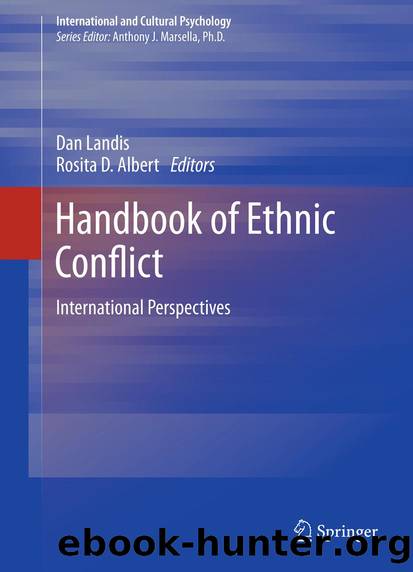Handbook of Ethnic Conflict by Dan Landis & Rosita D. Albert

Author:Dan Landis & Rosita D. Albert
Language: eng
Format: epub
Publisher: Springer US, Boston, MA
The terms Track I and Track II diplomacy were coined by Joseph Montville, a former US State Department official to distinguish between traditional diplomatic activities and unofficial, informal activities between members of conflicting parties (Montville, 1987). Track I diplomacy is conducted between official representatives of the state (or representatives of entities functioning in a state-like capacity to represent their side in the conflict). It may include heads of state, state department or ministry of foreign affairs officials, and other governmental departments and ministries. Track I diplomacy is primarily a tool for reaching mutual agreements that bring an end to conflicts, or at least a stop to the violence. It usually involves a third party, such as the United Nations, to help bring about a signed agreement between the states or parties involved in the conflict.
Track II diplomacy, consisting of dialogue between nonofficials, attempts to address the causes of the conflict by bringing people together to examine perceptions, stereotypes, distrust, and other factors that underlie different positions. Such approaches provide an environment that is free from the pressures and restraints of official diplomacy. By creating a space for dialogue that is nonjudgmental and noncoercive, that takes place in a safe setting, the hope is that participants will feel free to share perceptions, fears and needs, and to explore ideas for resolution that go beyond official positions. Track II processes are designed to encourage mutual understanding of each party’s perceptions and needs, the creation of new ideas for approaching the conflict, the adoption of a problem-solving orientation, and the development of relationships across conflict lines.
Conflict resolution theorists such as Fisher (1997) and Kelman (1995) have long made a case for the complementarity of Track I and Track II efforts. The civil-society peacebuilding work in Cyprus demonstrates how important it is for unofficial groups, or “Track II” actors (see Chigas, 2003), to develop effective communication links with official entities, or “Track I” actors (see Nan, 2003). Although citizen peace initiatives cannot substitute for official negotiations, the process of moving from conflict to resolution and, eventually, to a peace culture, requires contributions at the levels of both formal politics and civil-society.
The intersection of Track I and Track II efforts is reflected in the conceptual framework proposed by Lederach (1997). He identifies three levels of leadership in peacebuilding. At the top level, political and religious leaders focus primarily on high-level negotiations. At the grassroots level, leadership is made up of persons directly involved with the larger population that represents the base of society. Between these two levels, middle-range leaders in various sectors of society (education, business, health, etc.) are positioned so they have well-established connections with both officials and with the constituency that the top leaders represent. Lederach believed that the middle-range actors occupy a unique position in society, one that renders their work vital in the process of conflict transformation and sustainable peacebuilding in divided societies.
One of the primary ways that Track II peacebuilding can positively affect a stalemate is by allowing greater flexibility of thought and action in addressing and approaching the conflict.
Download
This site does not store any files on its server. We only index and link to content provided by other sites. Please contact the content providers to delete copyright contents if any and email us, we'll remove relevant links or contents immediately.
Rewire Your Anxious Brain by Catherine M. Pittman(18555)
Talking to Strangers by Malcolm Gladwell(13235)
The Art of Thinking Clearly by Rolf Dobelli(10234)
Mindhunter: Inside the FBI's Elite Serial Crime Unit by John E. Douglas & Mark Olshaker(9214)
Becoming Supernatural by Dr. Joe Dispenza(8127)
Change Your Questions, Change Your Life by Marilee Adams(7641)
Nudge - Improving Decisions about Health, Wealth, and Happiness by Thaler Sunstein(7622)
The Road Less Traveled by M. Scott Peck(7525)
The Lost Art of Listening by Michael P. Nichols(7412)
Enlightenment Now: The Case for Reason, Science, Humanism, and Progress by Steven Pinker(7243)
Mastermind: How to Think Like Sherlock Holmes by Maria Konnikova(7234)
Win Bigly by Scott Adams(7097)
The Way of Zen by Alan W. Watts(6513)
Daring Greatly by Brene Brown(6451)
Big Magic: Creative Living Beyond Fear by Elizabeth Gilbert(5618)
Grit by Angela Duckworth(5526)
Ego Is the Enemy by Ryan Holiday(5298)
Men In Love by Nancy Friday(5162)
Altered Sensations by David Pantalony(5048)
